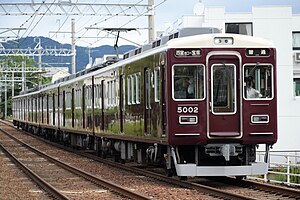You can help expand this article with text translated from the corresponding article in Japanese. (March 2024) Click for important translation instructions.
|
| Hankyu 5000 series | |
|---|---|
 5000 series on the Imazu Line 5000 series on the Imazu Line | |
| In service | 1967 |
| Manufacturer | Naniwa Kōki |
| Number built | 47 cars |
| Formation | 6 (formerly 8) cars per trainset |
| Operators | Hankyu Corporation |
| Lines served |
|
The Hankyu 5000 series (阪急電鉄5000系, Hankyū dentetsu 5000-kei) is an electric multiple unit (EMU) train type operated in Japan by the private railway operator Hankyu Railway since 1967. It is mainly operated on the Imazu Line. In the past, it was also operated on the Kobe Main Line.
History
The 5000 series were introduced in 1967 for direct operation onto the Sanyo Electric Railway via the newly-opened Kobe Rapid Railway Tozai Line. Sets were manufactured by Naniwa Koki, which would later become Alna Koki.
Trains were converted from 8-car sets to 6-car sets through 2020.
Formations
Sets are formed as follows:
| Car No. | 1 | 2 | 3 | 4 | 5 | 6 |
|---|---|---|---|---|---|---|
| Designation | M'c | M | T | M' | M | Tc |
| Numbering | 5000 | 5500 | 5550 | 5520 | 5500 | 5050 |
References
- 5000系|車両図鑑|阪急電鉄
- "50歳超えでも若々しい! イケてるオヤジ電車・阪急5000系". Tetsudo.com (in Japanese). 14 November 2021. Retrieved 2 April 2024.
- "阪急5000系がデビュー50周年…神戸本線と今津北線で記念列車を運行 4月7日から". Response Automotive Media (in Japanese). 3 April 2018. Retrieved 2 April 2024.
- "阪急5000系5000編成が正雀へ" [Hankyu 5000 series set 5000 is transferred to Shojaku]. Japan Railfan Magazine Online (in Japanese). 21 February 2020. Retrieved 2 April 2024.
- 私鉄車両編成表2021 [Private Railway Vehicle Organization Table 2021] (in Japanese). Japan: Kotsu Shimbunsha. 16 July 2021. p. 148. ISBN 9784330032214.
External links
| Hankyu trainsets | ||
|---|---|---|
| Kobe/Takarazuka Lines |  | |
| Kyoto Lines | ||
| Withdrawn | ||
This Japanese rail transport related article is a stub. You can help Misplaced Pages by expanding it. |
This electric locomotive-related article is a stub. You can help Misplaced Pages by expanding it. |